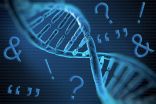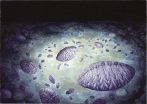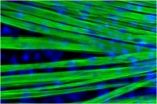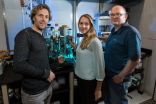(Press-News.org) San Francisco, CA - Since the classical studies of Jacob and Monod in the early 1960s, it has been evident that genome sequences contain not only blueprints for genes and the proteins that they encode, but also the instructions for a coordinated regulatory program that governs when, where and to what extent these genes and proteins are expressed. The execution of this regulatory code is what allows for the creation of very different cell- and tissue-types from the same set of genetic instructions found in the nucleus of every cell. A recent study published in PNAS (July 27, 2015) shows that critical aspects of this regulatory program are encoded by genomic sequence elements that were previously thought to be mere "junk DNA" with no important functions.
The vast majority of the human genome (~98% of the total genetic information) is not dedicated to encoding proteins, and this non-coding sequence was initially designated as "junk DNA" to underscore its lack of apparent function. Much of the so-called junk DNA in our genomes has accumulated over evolutionary time due to the activity of retrotransposable elements (RTEs), which are capable of moving (transposing) from one location to another in the genome and make copies of themselves when they do so. These elements have been considered as genomic parasites that exist by virtue of their ability to replicate themselves to high numbers within genomes without providing any beneficial function for the hosts in which they reside. However, recent studies on RTEs have shown that they can in fact encode important functions, and much of their functional activity turns out to be related to how genomes are regulated. RTEs have been linked to stem cell function, tissue differentiation, cancer progression and ultimately to aging and age-related pathologies.
The study by Wang et al. recently published in PNAS (July 27, 2015) provides a new perspective on the role that RTE-derived sequences play in the precise execution of the human genome's regulatory program. This study found that one particular class of RTEs - Mammalian-wide Interspersed Repeats (MIRs) - can serve as genetic landmarks that help to target specific regulatory mechanisms to a large number of genomic sites and thereby lead to the coordinated regulation of the genes located nearby these sites.
This discovery was spearheaded by a team of computational biologists, led by Dr. King Jordan, Associate Professor and Director of the Bioinformatics Graduate Program at the Georgia Institute of Technology, who performed a "big data" analysis of massive datasets generated by hundreds of scientists from dozens of laboratories around the world working as part of the "Encyclopedia of DNA Elements" or ENCODE project. Their comprehensive and integrated data analysis, conducted by primarily by Dr. Jianrong Wang from Dr. Jordan's team, allowed them to pinpoint the location of thousands of individual MIR elements in the human genome that appear to function as so-called "boundary elements" in T lymphocyte cells of the immune system.
Boundary elements are epigenetic regulatory sequences that separate transcriptionally active regions of the human genome from transcriptionally silent regions in a cell-type specific manner. In so doing, these critical regulatory elements help to provide distinct identities to different cell types, although they all contain identical sets of information. The regulatory programs that underlie these cell- and tissue-specific functions and identities are based largely on genome packaging. Genes that should not be expressed in a given cell or tissue are located in tightly packaged regions of the genome and inaccessible to the transcription factors that would otherwise turn them on. These boundary elements help to establish the geography of genome packaging by delineating the margins between silent regions in which genes are not expressed and active regions in which they are. In this critical role, boundary elements help to control the timing and extent of gene expression across the entire genome. As a result, defects in the organization of the genome by boundary elements are highly relevant for physiological and pathological processes.
"Our colleagues at the Georgia Institute of Technology were able to build upon our early discovery that another class of retrotransposon, the SINEB2 element, can provide boundary function at the mouse growth hormone locus," said Dr. Victoria Lunyak, CEO of Aelan Cell Technologies whose research team collaborated with Jordan lab on this project.
"We randomly picked a hand full of the MIR sequences predicted to serve as boundary elements by the Jordan lab and experimentally validated their activity in mouse cell lines and, with help of our Spanish collaborators, in Zebra fish upon embryonic development," Dr. Lunyak said. "This testing revealed that MIR sequences can serve as punctuation marks within our genome that enable cells to correctly read and comprehend the message transmitted by the genomic sequences."
"One thing that is particularly striking is the fact that these punctuation marks, as Victoria calls them, play a role that is deeply evolutionary conserved," said Dr. Jordan. "The same exact MIR sequences were able to function as boundaries in human CD4+ lymphocytes, in mouse cell models and in Zebrafish."
"This is an important discovery because the understanding of how RTEs punctuate messages encoded in the human genome can help researchers to develop treatments for a wide variety of human diseases, including aging," added Dr. Lunyak
Aging is characterized by a number of global changes in genome organization and function, and aging-associated defects in how our genome is packaged can have severe pathological consequences. In particular, age-related defects in genomic packaging can greatly increase the susceptibility of the genome to damage. Based on the discoveries published in their PNAS paper, the Jordan lab at Georgia Tech and the Lunyak team at Aelan Cell Technologies and their partner Nuclea Biotechnologies are now working towards the development of novel diagnostic and therapeutic strategies that target the critical roles of epigenetic regulators, such as human retrotransposons, in coordinating cell-type specific regulatory programs.
The study was published in the journal Proceedings of the National Academy of Sciences, USA.
INFORMATION:
Nanotechnology could one day provide an inhaled vehicle to deliver targeted therapeutic genes for those suffering from life-threatening lung disorders.
Researchers may have discovered first gene delivery system that efficiently penetrates the hard-to-breach human airway mucus barrier of lung tissue.
Researchers at the Johns Hopkins University School of Medicine, Johns Hopkins University Department of Chemical and Biomolecular Engineering, and Federal University of Rio de Janeiro in Brazil have designed a DNA-loaded nanoparticle that can pass through the mucus barrier ...
The field of medical genetics is swiftly evolving. It's a period of rapid scientific discovery, new technologies and subsequent translation into medical practice, public policy and public health. But what role should the Medical Genetics specialist have since genetics impacts all patients and specialties in some way? In an effort to clearly define the changing role of the specialty of Medical Genetics and the distinction between Medical Geneticists and other genetics healthcare professionals, the American College of Medical Genetics and Genomics (ACMG) has has just released ...
Various sight recovery therapies are being developed by companies around the world, offering new hope for people who are blind. But little is known about what the world will look like to patients who undergo those procedures.
A new University of Washington study seeks to answer that question and offers visual simulations of what someone with restored vision might see. The study concludes that while important advancements have been made in the field, the vision provided by sight recovery technologies may be very different from what scientists and patients had previously ...
Recent research has shown that the more time employees spend in their chairs, the more likely they are to develop serious health problems such as diabetes, heart disease, and obesity. The July special issue of Ergonomics in Design examines the health and safety effects of the sedentary workplace, the pros and cons of alternatives to sitting at work (for example, sit-stand and treadmill workstations, ball chairs), and proposed workplace design solutions. The full text of the issue, guest edited by Jack Dennerlein, is now available online and may be found at http://erg.sagepub.com/content/current.
"With ...
Scientists from the University of Leeds have uncovered further evidence that the protective buffers at the ends of chromosomes - known as telomeres - are fundamental to the understanding of the deadliest form of skin cancer, melanoma.
A team of international researchers, co-led by Dr Mark Iles from the University's School of Medicine and St James's University Hospital in Leeds, has uncovered five new common genetic risk factors for melanoma. They have also confirmed two others previously suspected to be risk factors.
Dr Iles said: "This research establishes further ...
Researchers led by the University of Cambridge have found the earliest example of reproduction in a complex organism. Their new study has found that some organisms known as rangeomorphs, which lived 565 million years ago, reproduced by taking a joint approach: they first sent out an 'advance party' to settle in a new area, followed by rapid colonisation of the new neighbourhood. The results, reported today in the journal Nature, could aid in revealing the origins of our modern marine environment.
Using statistical techniques to assess the distribution of populations ...
High-dose vitamin D supplementation in postmenopausal women was not associated with beneficial effects on bone mineral density, muscle function, muscle mass or falls, according to the results of a randomized clinical trial published online by JAMA Internal Medicine.
Low levels of vitamin D contribute to osteoporosis because of decreased total fractional calcium absorption (TFCA) and nearly half of postmenopausal women sustain an osteoporotic fracture. However, experts disagree on the optimal vitamin D level for skeletal health. Some experts contend that optimal serum ...
A recently discovered family of small RNA molecules, some of which have been implicated in cancer progression, has just gotten much larger thanks to a new RNA sequencing technique developed by researchers at UC Santa Cruz.
The technique, described in a paper published August 3 in Nature Methods, provides sensitive detection of small RNAs that are chemically modified (methylated) after being transcribed from the genome. The researchers used the technique to reveal an abundance of modified fragments derived from transfer RNA molecules in both yeast cells and human cells.
"Transfer ...
Skeletal muscle is one of the most abundant tissue types in the human body, but has proven difficult to produce in large quantities in the lab. Unlike other cell types, such as heart cells, neurons and cells found in the gut, previous attempts to efficiently and accurately derive muscle cells from pre-cursor cells or culture have not been fruitful. In a new study published this week in Nature Biotechnology, investigators from Brigham and Women's Hospital (BWH) report that by identifying and mimicking important developmental cues, they have been able to drive cells to grow ...
LA JOLLA--T cells are the guardians of our bodies: they constantly search for harmful invaders and diseased cells, ready to swarm and kill off any threats. A better understanding of these watchful sentries could allow scientists to boost the immune response against evasive dangers (e.g., cancer or infections), or to silence it when it mistakenly attacks the body itself (e.g., autoimmune disorders or allergies).
Now, scientists at the Salk Institute have discovered that T cell triggering relies on a dynamic protein network at the cell surface, as reported in August 3, ...



